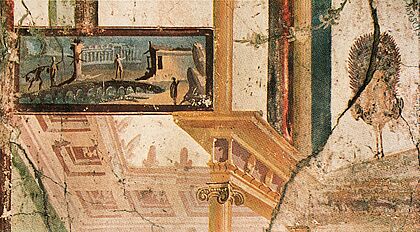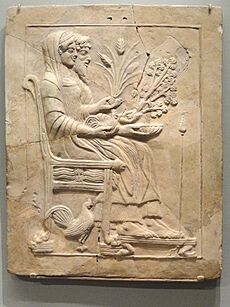Pinax facts for kids
A pinax (pronounced PEE-nax) was a special kind of tablet or plaque from ancient Greece. The word pinax (plural: pinakes) means 'board' in Greek.
These pinakes were often votive tablets. This means they were gifts offered to the gods in a sanctuary (a holy place). They could also be placed in burial chambers as memorials for the dead.
Pinakes were made from different materials. These included painted wood, terracotta (baked clay), marble, or bronze. Many museums around the world have pinakes in their collections.
In ancient Roman wall painting, especially in the Third and Fourth Style, a pinax was a framed picture painted on a wall.
Contents
What is a Pinax?
The ancient Greeks used the word pinax for different things. It could mean a simple plate or a writing tablet covered in wax. In early Christian times, painted icons (religious images) were also called pinakes.
In the theatre of ancient Greece, pinakes were images used as scenery. They were often painted on cloth or carved from stone or wood. These were hung behind or below the stage. The word pinacotheca, which means a picture gallery, comes from this use.
Materials and How They Were Used

When archaeologists find wooden pinakes, their paint is usually almost gone. The Pitsa panels are a rare exception where the paint is still visible. Terracotta pinakes were also brightly painted.
Marble pinakes were carved one by one. Terracotta ones were made using molds. Bronze pinakes were often made using the lost-wax casting method. This allowed many copies to be made from one model.
Some very old gold plaques from the 7th century BC have been found. Many came from Rhodes. They show figures of gods, like Artemis, in an old style called Daedalic.
Pinakes often had two holes at the top. These were for a cord so they could be hung up. Ancient vase-paintings show pinakes hanging on temple walls. They are also shown hanging from trees in holy areas. The Roman architect Vitruvius wrote about pinakes being in temples and even in private homes. A collection of pinakes was called a pinakothek. Today, this word is used for an art museum, like the Alte Pinakothek in Munich, Germany.
Callimachus, a poet and scholar from the Library of Alexandria, created a list of the library's books. He called this list Pinakes. This term was later used for other library catalogs.
Where Pinakes Have Been Found
Many pinakes have been found in Locri, a city in southern Italy. Thousands were carefully buried there. Most came from the sanctuaries of Persephone or Aphrodite.
Another large group of over 1,000 pottery pinakes was found near Corinth, at a place called Penteskouphia. Most of these are now in the Antikensammlung Berlin museum. Some are in Corinth and the Louvre museum. Besides religious scenes, some of these pinakes show potters at work. Berlin also has fragments from the Kerameikos cemetery in Athens. Many of these were made by a famous painter named Exekias.
Pinakes in Etruscan Art
In Etruscan art, larger terracotta plaques have been found in tombs. These were bigger than typical Greek pinakes. Some formed a series, creating a kind of portable wall painting. Wealthy Etruscan families often had tombs with painted walls, which was not common in Greece.
The "Boccanera" tomb at the Banditaccia necropolis in Cerveteri had five panels. They were almost a meter tall and placed around the wall. These are now in the British Museum. Three panels show one scene, possibly the Judgement of Paris. The other two were placed at the entrance, with sphinxes guarding the tomb. These date back to about 560 BC. Pieces of similar panels have been found in city centers. These likely came from temples, important houses, and other buildings. They show scenes from everyday life.
See also
 In Spanish: Pínax para niños
In Spanish: Pínax para niños
- Corpus Vasorum Antiquorum
- Ex-voto
- Grave goods
- Votive site
- Ema (Shinto) – similar offerings in Shinto



